Abstract
OBJECTIVES. This study assessed the association of Jewish religious observance with mortality by comparing religious and secular kibbutzim. These collectives are highly similar in social structure and economic function and are cohesive and supportive communities. METHODS. In a 16-year (1970 through 1985) historical prospective study of mortality in 11 religious and 11 matched secular kibbutzim in Israel, 268 deaths occurred among 3900 men and women 35 years of age and older during 41347 person-years of observation. RESULTS. Mortality was considerably higher in secular kibbutzim. Cox proportional hazards analysis was used to adjust for age and the matched design; rate ratios were 1.67 (95% confidence interval [CI]=1.17, 2.39) for men, 2.67 (95% CI=1.55, 4.60) for women, and 1.93 (95% CI=1.44, 2.59) overall. Kaplan-Meier survival analysis of birth cohorts confirmed the association. The lower mortality in religious kibbutzim was consistent for all major causes of death. CONCLUSIONS. Belonging to a religious collective was associated with a strong protective effect not attributable to confounding by sociodemographic factors. Elucidation of mechanisms mediating this effect may provide etiologic insights and leads for intervention.
Full text
PDF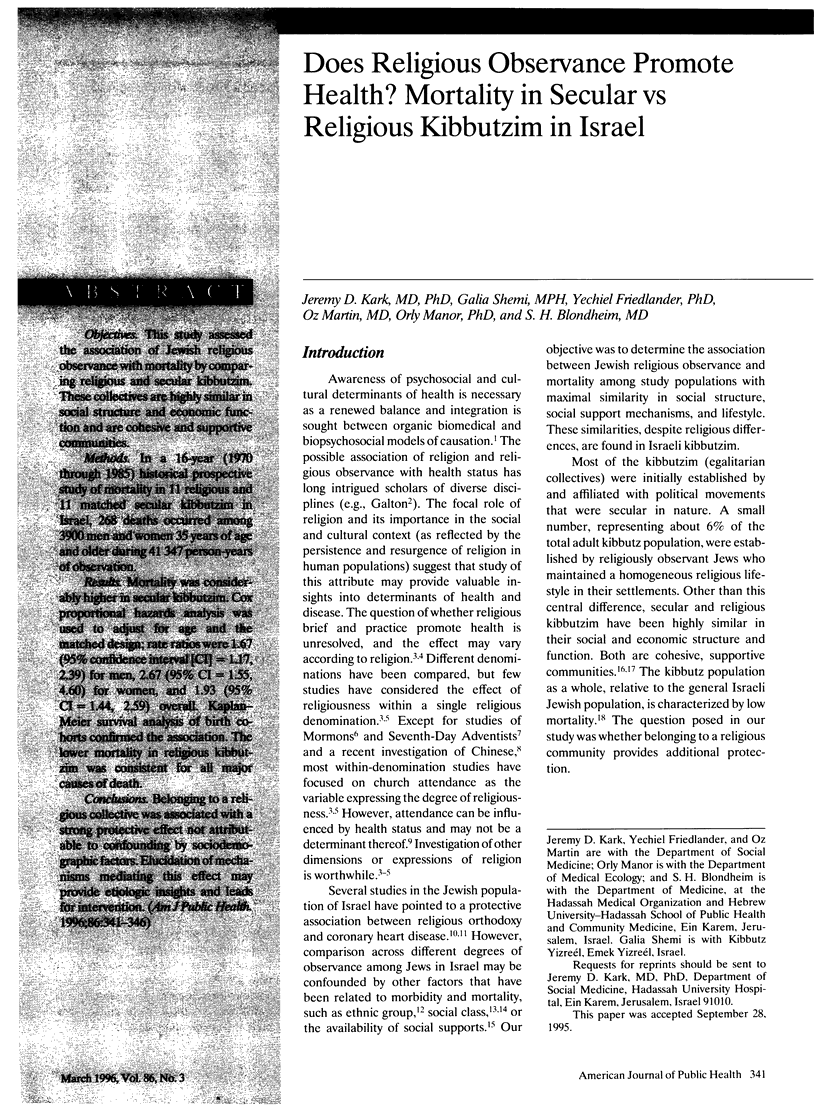
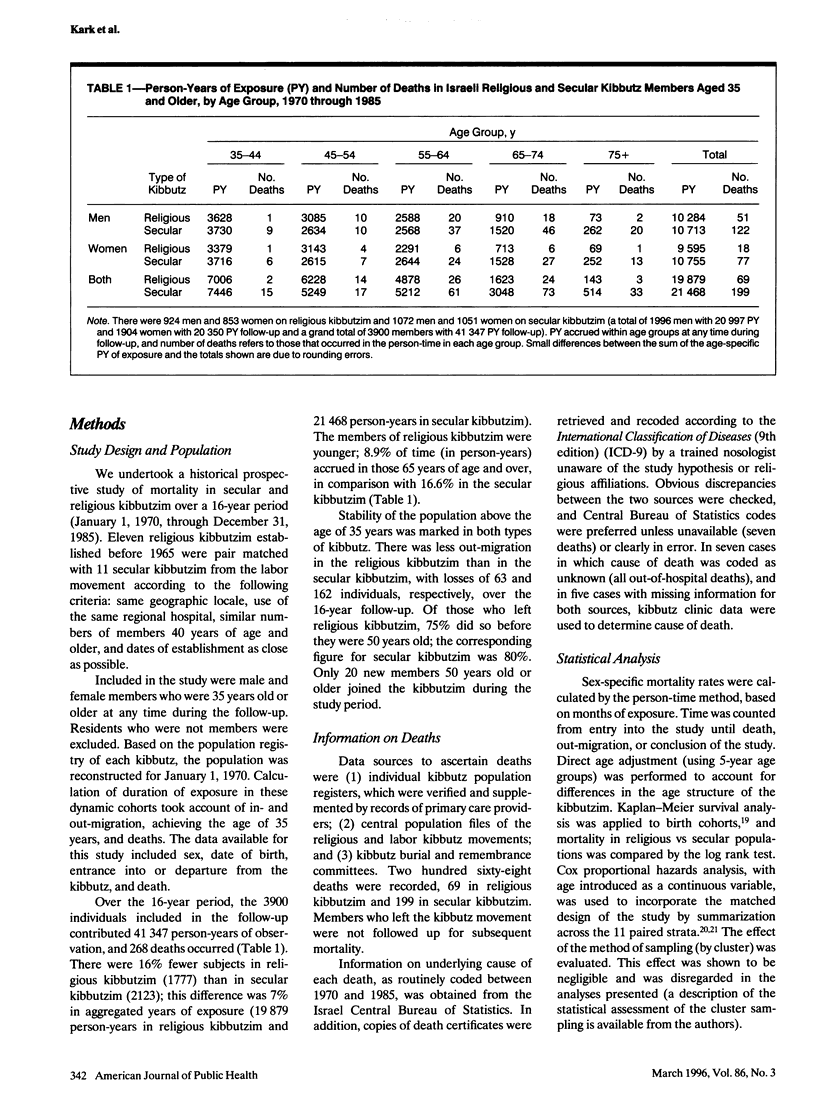

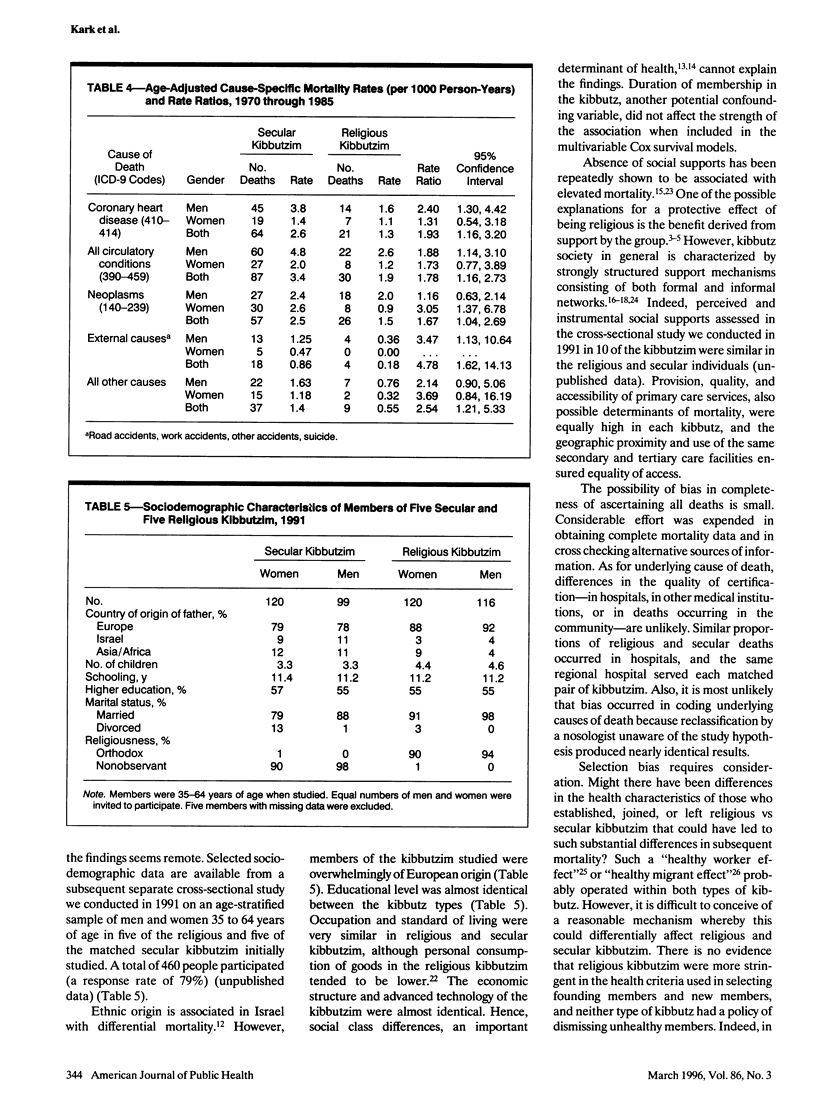
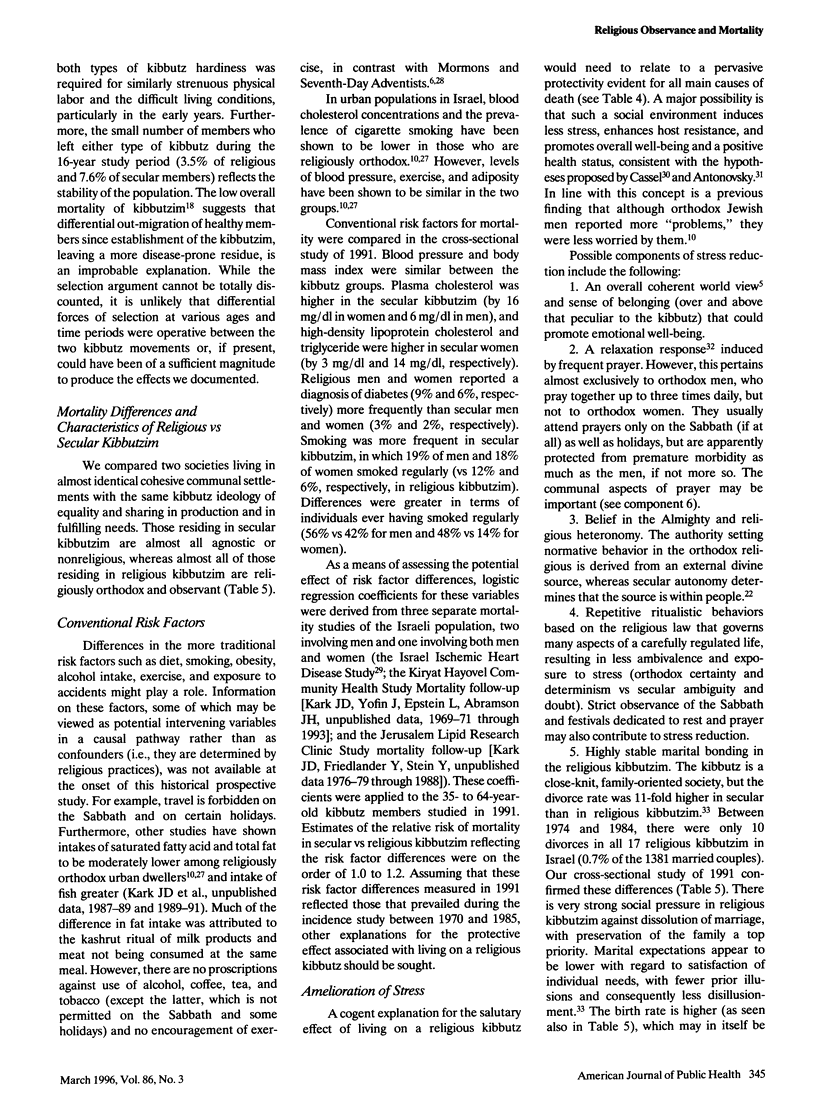
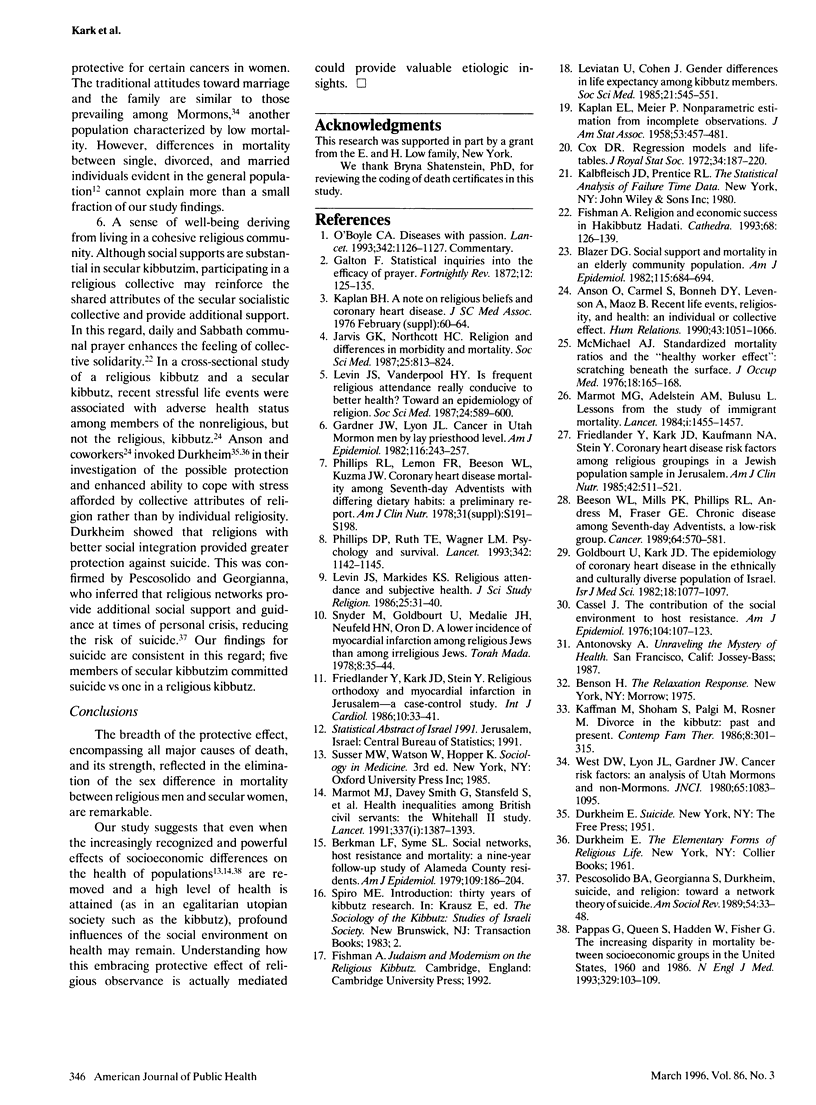
Selected References
These references are in PubMed. This may not be the complete list of references from this article.
- Beeson W. L., Mills P. K., Phillips R. L., Andress M., Fraser G. E. Chronic disease among Seventh-day Adventists, a low-risk group. Rationale, methodology, and description of the population. Cancer. 1989 Aug 1;64(3):570–581. doi: 10.1002/1097-0142(19890801)64:3<570::aid-cncr2820640303>3.0.co;2-4. [DOI] [PubMed] [Google Scholar]
- Berkman L. F., Syme S. L. Social networks, host resistance, and mortality: a nine-year follow-up study of Alameda County residents. Am J Epidemiol. 1979 Feb;109(2):186–204. doi: 10.1093/oxfordjournals.aje.a112674. [DOI] [PubMed] [Google Scholar]
- Blazer D. G. Social support and mortality in an elderly community population. Am J Epidemiol. 1982 May;115(5):684–694. doi: 10.1093/oxfordjournals.aje.a113351. [DOI] [PubMed] [Google Scholar]
- Cassel J. The contribution of the social environment to host resistance: the Fourth Wade Hampton Frost Lecture. Am J Epidemiol. 1976 Aug;104(2):107–123. doi: 10.1093/oxfordjournals.aje.a112281. [DOI] [PubMed] [Google Scholar]
- Friedlander Y., Kark J. D., Kaufmann N. A., Stein Y. Coronary heart disease risk factors among religious groupings in a Jewish population sample in Jerusalem. Am J Clin Nutr. 1985 Sep;42(3):511–521. doi: 10.1093/ajcn/42.3.511. [DOI] [PubMed] [Google Scholar]
- Friedlander Y., Kark J. D., Stein Y. Religious orthodoxy and myocardial infarction in Jerusalem--a case control study. Int J Cardiol. 1986 Jan;10(1):33–41. doi: 10.1016/0167-5273(86)90163-4. [DOI] [PubMed] [Google Scholar]
- Gardner J. W., Lyon J. L. Cancer in Utah Mormon men by lay priesthood level. Am J Epidemiol. 1982 Aug;116(2):243–257. doi: 10.1093/oxfordjournals.aje.a113409. [DOI] [PubMed] [Google Scholar]
- Goldbourt U., Kark J. D. The epidemiology of coronary heart disease in the ethnically and culturally diverse population of Israel. A review. Isr J Med Sci. 1982 Nov;18(11):1077–1097. [PubMed] [Google Scholar]
- Jarvis G. K., Northcott H. C. Religion and differences in morbidity and mortality. Soc Sci Med. 1987;25(7):813–824. doi: 10.1016/0277-9536(87)90039-6. [DOI] [PubMed] [Google Scholar]
- Leviatan U., Cohen J. Gender differences in life expectancy among kibbutz members. Soc Sci Med. 1985;21(5):545–551. doi: 10.1016/0277-9536(85)90039-5. [DOI] [PubMed] [Google Scholar]
- Levin J. S., Vanderpool H. Y. Is frequent religious attendance really conducive to better health? Toward an epidemiology of religion. Soc Sci Med. 1987;24(7):589–600. doi: 10.1016/0277-9536(87)90063-3. [DOI] [PubMed] [Google Scholar]
- Marmot M. G., Adelstein A. M., Bulusu L. Lessons from the study of immigrant mortality. Lancet. 1984 Jun 30;1(8392):1455–1457. doi: 10.1016/s0140-6736(84)91943-3. [DOI] [PubMed] [Google Scholar]
- Marmot M. G., Smith G. D., Stansfeld S., Patel C., North F., Head J., White I., Brunner E., Feeney A. Health inequalities among British civil servants: the Whitehall II study. Lancet. 1991 Jun 8;337(8754):1387–1393. doi: 10.1016/0140-6736(91)93068-k. [DOI] [PubMed] [Google Scholar]
- McMichael A. J. Standardized mortality ratios and the "healthy worker effect": Scratching beneath the surface. J Occup Med. 1976 Mar;18(3):165–168. doi: 10.1097/00043764-197603000-00009. [DOI] [PubMed] [Google Scholar]
- O'Boyle C. A. Diseases with passion. Lancet. 1993 Nov 6;342(8880):1126–1127. doi: 10.1016/0140-6736(93)92116-b. [DOI] [PubMed] [Google Scholar]
- Pappas G., Queen S., Hadden W., Fisher G. The increasing disparity in mortality between socioeconomic groups in the United States, 1960 and 1986. N Engl J Med. 1993 Jul 8;329(2):103–109. doi: 10.1056/NEJM199307083290207. [DOI] [PubMed] [Google Scholar]
- Pescosolido B. A., Georgianna S. Durkheim, suicide, and religion: toward a network theory of suicide. Am Sociol Rev. 1989;54(1):33–48. [PubMed] [Google Scholar]
- Phillips D. P., Ruth T. E., Wagner L. M. Psychology and survival. Lancet. 1993 Nov 6;342(8880):1142–1145. doi: 10.1016/0140-6736(93)92124-c. [DOI] [PubMed] [Google Scholar]
- Phillips R. L., Lemon F. R., Beeson W. L., Kuzma J. W. Coronary heart disease mortality among Seventh-Day Adventists with differing dietary habits: a preliminary report. Am J Clin Nutr. 1978 Oct;31(10 Suppl):S191–S198. doi: 10.1093/ajcn/31.10.S191. [DOI] [PubMed] [Google Scholar]
- West D. W., Lyon J. L., Gardner J. W. Cancer risk factors: an analysis of Utah Mormons and non-Mormons. J Natl Cancer Inst. 1980 Nov;65(5):1083–1095. [PubMed] [Google Scholar]


